#Liberation Of Geoff
Explore tagged Tumblr posts
Text
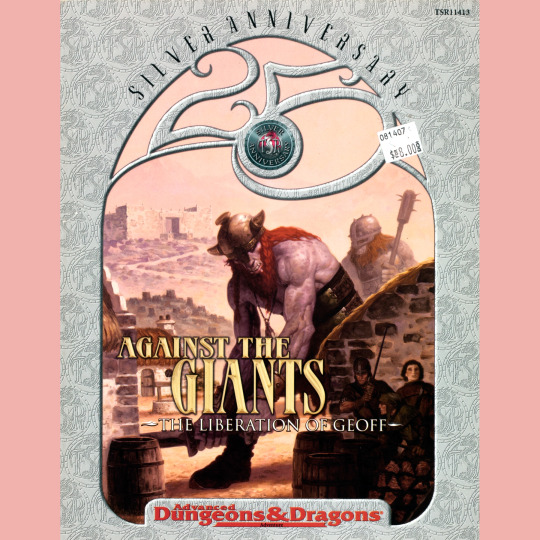
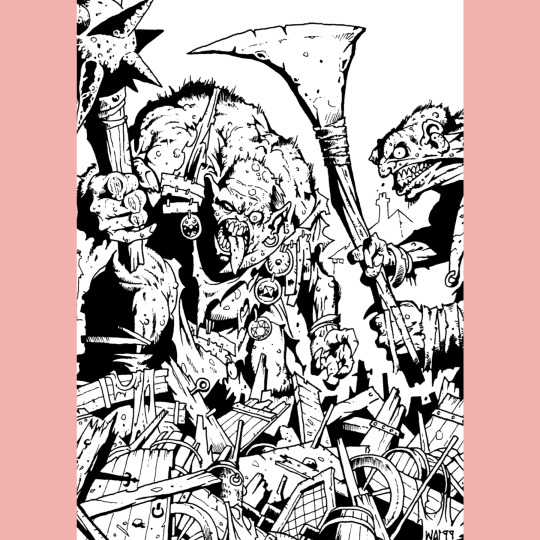



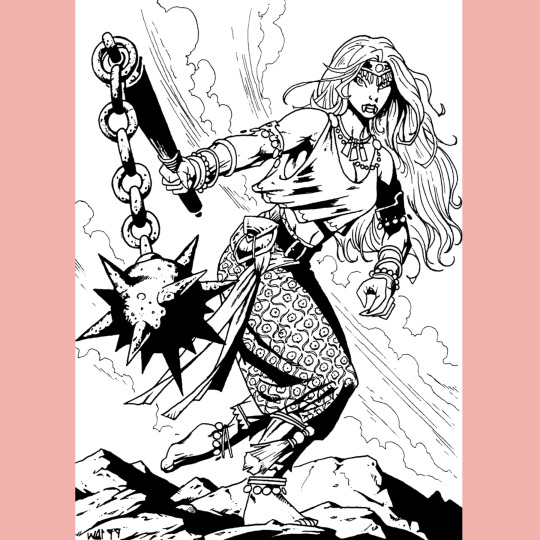
After TSR died and was brought back to an undead half-life by Wizards of the Coast, there came a set of adventures that returned to classic 1e adventure sites. The first was 1998’s Return to the Tomb of Horrors box set (which I covered a while back). It was followed a trio of “silver anniversary” branded books and modules, first of which was Against the Giants: The Liberation of Geoff (1999). I know Geoff is a dutchy or whatever in Greyhawk, but I still have a hard time with the title because it sounds like it should be a novel about a guy named Geoff’s sexual awakening, possibly written by D. H. Lawrence.
Anyway, Geoff was invaded and subjugated by giants. You need to kick ‘em out. The first section of the book presents the original G-series modules, updated to 2E. That’s followed by a general sort of sourcebook on Geoff, which is further divided into a collection of adventure sites which are basically towns subjugated by various evil humanoids — orc town, ogre town, wererat town. The three main locales (each accompanied by a couple minor locations) form up three additions G-series modules, sorta. There’s G4: Mount Rungnirheim (more frost giants?), G5: Castle Thrasmotnir (more fire giants?) and G6: Cloud Islands of the Sakhut (cloud giants). It is odd to me that we got more frost and fire (god, just typing that out, I heard it sung by Cirith Ungol) when the stone giants and storm giants are out there, getting no love. The second batch of frost giants at least are prone to having multiple heads, which seems weird but also I like it.
And that’s…basically it. If you want more giants, you got more giants! The book mostly shrugs at the original G-series sub-plot involving the drow — if you finished G3, the plot’s been disrupted, the caves collapsed, the drow in retreat for however long it takes them to build up their nerve again. I’m OK with that!
Brom on the cover. Wayne Reynolds inside. It’s a good looking module.
#tabletop rpg#roleplaying game#dungeons & dragons#rpg#ttrpg#d&d#Against The Giants#Liberation Of Geoff#noimport
94 notes
·
View notes
Text

Against the Giants: The Liberation of Geoff Cover Art by Gerald Brom
#Advanced Dungeons & Dragons#AD&D#Against the Gianst: The Liberation of Geoff#Covers#Cover Art#Fantasy#Art#Gerald Brom#Brom#TSR#Wizards of the Coast
53 notes
·
View notes
Text
By: Julian Adorney, Mark Johnson and Geoff Laughton
Published: Jan 18, 2025
Unlike the Civil Rights Movement, which chose sympathetic figures like Rosa Parks, SJFs have lionized individuals whose actions repel most Americans.
Social Justice Fundamentalism (SJF) is doomed.
How can we say this so confidently? And why do we believe that SJF ideology will meet its demise relatively quickly now that the tide is beginning to turn?
For one thing, in their zeal to oppose the out-group that they deem responsible for all oppression, many SJFs have adopted an anything-goes mentality. Threats and violence are justified, they claim, as long as they target the “correct” people. This creates truly terrible brand ambassadors. For example, SJFs have lionized Luigi Mangione, the man suspected of killing UnitedHealthcare CEO Brian Thompson with one post on X garnering over 36,000 likes that compared him to Nelson Mandela, stating, “They called Nelson Mandela a ‘terrorist’ too, Luigi. You’re in good company.” Similarly, many SJFs leaped to defend Christian Cooper, the black man a white woman reported to the police in 2020, even after evidence emerged that he had threatened her and her dog. Furthermore, following Hamas’ October 7 attack on Israeli civilians, a survey showed that 51 percent of respondents aged 18-24 believed that “the Hamas killing of 1200 Israeli civilians in Israel can be justified by the grievances of Palestinians.”
Contrast this with the Civil Rights Movement. When Martin Luther King Jr. and his allies opposed the Montgomery Bus Boycott, they chose Rosa Parks as a brand ambassador. Why? It wasn’t because Parks was the first black person to refuse to sit in the back of the bus. It was because she was a woman of noble character with a flawless background. Civil rights protestors, aware of the uphill battle they faced against a prejudiced nation, needed an ambassador whose plight would evoke sympathy in the hearts of fellow Americans. If a woman like this could be arrested under Jim Crow, the nation must be encouraged to reconsider the justice of segregation.
But there’s nothing sympathetic about Mangione or Cooper. There is nothing sympathetic about killing a husband and father in cold blood, simply because he was the CEO of an unpopular company; or about a man telling a woman out walking her dog that he would do “something” to her and her dog that “she was not going to like.” There is nothing sympathetic about the brutal rapes and murders of teenaged civilians that characterized Hamas’ October 7 attack. When SJFs prop up these characters and act as if their threats and violence are heroic, they lose the goodwill of most decent Americans. There’s a reason that the far-left’s rabid anti-Semitism in the wake of Hamas’ attack turned so many Democrats and progressives away from SJF.
However, it’s not just that so many SJFs endorse an anything-goes mentality against their so-called enemies. It’s also that, sooner or later, everyone becomes an enemy. In the wake of the #MeToo movement, “Believe all women” became a popular slogan. That is, until 2020, when a few women were accused of racism for calling the police on black men (with some justification, in many cases). Then “Believe all women” shifted to “white women need to shut their mouths and stop lying!” Black men were celebrated on the left until it came out that many didn’t support Kamala Harris, at which point they were accused of being “white-adjacent” (by MSNBC’s Joy Reid) and sexist (by Barack Obama). Even sexual assault survivors and progressive transwomen are getting pilloried for failing to support SJF ideology. For many too-online SJFs, nothing short of absolute obedience to the party line will suffice. This is self-destructive even in the best of times, but it becomes downright political suicide when the party line is also constantly shifting.
We've seen this throughout history: common-enemy identity politics collapse in part because such movements inevitably eat their own. During the Cultural Revolution in China, Mao’s Red Guards were initially unified in attacking the targets that Mao assigned them (the bourgeoisie and the “Four olds”). But Xi Van Fleet, a commentator who lived through the revolution, explains how at a certain point the Red Guards “start[ed] to fight each other.” They had dismantled their other enemies, leaving a power vacuum; and so they started forming into factions to seek their own power. The resultant violence, as factions of Red Guards attacked each other, was awful: Van Fleet compares it to a “civil war.” Nor was the infighting relegated to just the Red Guards. Mao had created and unleashed them, but at a certain point, Van Fleet says, he decided to get rid of them. He “killed tens of thousands of Red Guards,” and then exiled their leaders to the countryside for hard physical labor. The revolution wasn’t destroyed by violence from without; it consumed itself in an orgy of internal violence that no-one could forget.
Most SJFs lack the brutality and desire for violence that characterized the Red Guard. However, the lesson is the same: because common-enemy identity politics requires an out-group to unite against, its members will eventually turn on one another, transforming former allies into the new out-group.
As a result, many SJFs struggle to form stable coalitions. In 2022, The Intercept published a long story about why progressive organizations were spending all their time and energy gripped by internal turmoil instead of successfully mobilizing and fighting for legislative change. The scope of the problem the authors documented was enormous:
…the progressive advocacy space across the board…has, more or less, effectively ceased to function. The Sierra Club, Demos, the American Civil Liberties Union, Color of Change, the Movement for Black Lives, Human Rights Campaign, Time’s Up, the Sunrise Movement, and many other organizations have seen wrenching and debilitating turmoil in the past couple years.
Part of the problem, the authors argued, was that bad-faith actors were using the “language of social justice” to “smuggle through standard grievances” about the workplace, such as wanting more time off and easier schedules. However, much of the turmoil that gripped these institutions came in the form of circular firing squads: unless the organization was perfectly representative and lived out every tenet of SJF completely, it shouldn’t be allowed to function. “If your reproductive justice organization isn’t Black and brown it’s white supremacy in heels co-opting a WOC movement,” read a typical message.
To illustrate what this looks like, consider the case of Dr. Lindo Bacon. Bacon is an SJF nutritionist who published a (deeply-flawed) book called Health At Every Size (which we reviewed here). Despite its scholastic shortcomings, Bacon’s book became a bestseller and put the Health at Every Size movement and the Association For Size Diversity and Health (ASDAH) on the map.
However, when Bacon proposed publishing a 15th anniversary version of his book to bring more visibility to the cause, ASDAH leaders rebuked him. They suggested that instead of publishing a 15th anniversary edition, Bacon should let his book go out of print “so that new voices who are deeply impacted by fat hatred could be ushered in.” They lectured him about his privilege and urged him to consider “passing this opportunity along to any of the fat, BIPOC, disabled, lower socioeconomic status, etc folks who are doing this work and whose voices need to be centered and uplifted.” If he refused their suggestions, they warned, he would be “perpetuating harm by centering the experience and perspective of a relatively affluent, thin/straight-sized, white person.” Following further exchanges, ASDAH cut ties with Bacon explosively, instructed him not to write or publish an updated version of his book, and then published the entire email exchange in a blog titled “Holding Lindo Bacon Accountable for Repeated Harm in the Fat Liberation & HAES® Communities.” It makes for a truly remarkable read, illustrating why many SJFs struggle to form coalitions: because everyone possesses some kind of privilege, individuals and groups can engage in severe conflicts under the guise of addressing privilege and advocating for social justice.
(Of course, not every SJF behaves this way, and many genuinely desire to collaborate in pursuit of a more inclusive society. However, what happened to Bacon is not uncommon. As a movement, SJFs experience a disproportionately high amount of infighting).
This leads to the final reason that SJF is likely doomed: the unpopularity of its ideas.
Many of SJF’s biggest causes remain deeply unpopular with the American people. For instance, many SJFs consider Hamas’ October 7 attack on Israel as justified, but most Americans disagree. A 2024 Pew survey found that 66 percent of respondents considered “the way Hamas carried out the Oct. 7 attack” to be “completely unacceptable,” compared to just 2 percent who found it “completely acceptable.” Another foundational cause of this ideology—defunding the police—also lacks mainstream support. In 2021, three times as many Americans wanted increased police funding (46 percent) compared to those who wanted it decreased (15 percent). Similarly, on transgender issues, 68 percent of adults opposed giving puberty-blocking medications to so-called “transgender children” aged 10-14, and over 60 percent of Americans believed that transgender women should not be allowed to participate in women’s sports. The term “LatinX,” is found offensive by 40 percent of Hispanics and is used by only 2 percent. On issue after issue, SJF ideas and policy positions are wildly unpopular.
But the problem isn’t just that many SJF ideas are unpopular; after all, previously unpopular ideas like gay marriage and the civil rights movement have become mainstream. The real issue is that many SJFs fundamentally reject the idea that they can—or should—persuade their fellow Americans of the merits of their ideas. For many SJFs, the rest of us are viewed as irredeemably prejudiced or as oppressors, incapable of being reasoned with. If we’re white, they claim, we oppose SJF ideas to preserve our privilege; if we’re black or brown, we do so due to “internalized oppression.” In either case, our criticism doesn’t really count because, according to SJF scholars, our criticisms are not coming from a sincere place.
In lieu of persuasion, many SJFs have tried to guilt, browbeat, and shame the rest of us into adopting their ideas. The problem, from a marketing standpoint, is that this only works in the short term. Initially, being labeled a racist might lead someone to feel remorseful and ask the SJF insulting them what they can do better. But by the tenth time that the charge is leveled—especially when directed at minorities who don’t toe the SJF line—it loses its sting. You can only bully people for so long before they stop putting up with it.
An already unpopular ideology that depends on guilt and coercion rather than persuasion is likely to become increasingly unpopular over time.
So, if SJF is on the decline, what should we do?
Firstly, we must continue fighting to expose the broken ideas at the heart of SJF ideology. SJF ideology might be doomed, but it can still do a lot of damage in the meantime; therefore, we should work to shorten its lifespan. The Cultural Revolution only lasted 10 years, but in that time it wreaked immense havoc. Had critics been willing and able to stand up and speak against the revolution so that it ended in five years instead of 10, they could have saved many lives.
We should also advocate explicitly for common-humanity identity politics, as aptly described by Pauli Murray in 1945: “When my brothers try to draw a circle to exclude me, I shall draw a larger circle to include them.” There’s a real danger any time a destructive ideology begins to lose its power: those of us harmed by it might seize control and try to punish its followers. This can feel like justice, but in practice it’s just vengeance. We end up directing our anger not at those who wronged us but at anyone associated with the same group as those who wronged us. This perpetuates an endless cycle of tit-for-tat retaliation.
Instead of turning the tables, those of us who oppose SJF ideology should rise above. We should offer the hand of fellowship and brotherhood to the SJFs we know. Many have noble intentions and an ability to see forms of prejudice that society has historically turned a blind eye to. Where these insights align with common-humanity identity politics, we should welcome them.
SJF ideology is on its way out because the most toxic components of the ideology are also the least palatable to ordinary Americans. That’s good news. Now is not the time to beat those who subscribe to SJF ideology; it’s the time to win them.
#Julian Adorney#Mark Johnson#Geoff Laughton#social justice fundamentalism#social justice#critical social justice#fundamentalism#defund the police#Latinx#hamas supporters#israel#palestine#Hamas terrorism#liberalism#liberal ethics#liberal values#classical liberalism#guilt#coercion#cancel culture#internalized oppression#privilege#woke#wokeness#cult of woke#wokeism#wokeness as religion#religion is a mental illness
3 notes
·
View notes
Text
The Japanese Version of Deltarune
about a week ago i decided to translate japanese deltarune because i was curious and bored. i found a lot of stuff that i haven’t heard anyone talk about before!
i only translated chapter 2 because i got to the cliffs and remembered that watching/playing chapter 1 over and over again is really boring to me. might do it when/if i finish writing the post.
uhhh a few warnings. i’m not fluent in japanese whatsoever (i’m like n4 level? i think?), and i might not explain this very well to people who don’t know anything about the language. if you’re confused about anything i say, just ask and i’ll explain it in better detail.
i got all of the gameplay from tsuwahasu’s playthroughs of chapter 2 (pacifist and weird route), so all of the screenshots will be from his vods. i picked his vod to watch somewhat randomly so i was very surprised when he not only got all the easter eggs/secrets on a blind playthrough besides the egg room, but also beat spamton neo in one try, god damn
also i’m not the first person to look at the jp version of deltarune. please look at these posts/videos if you want to see stuff that’s already known in better detail:
skellfamily (light/dark world writing, characters’ pronouns and speech patterns) | suzyundertale (ch2 character names, some jokes) suzyundertale again (the gonermaker sequence) | duxarcana and halfbreadchaos (character in the code) | kazarinn (comments from the translators)
reblogs highly appreciated—this took a ton of time!!!
NOW.
LET US BEGIN.
first things first. the gonermaker sequence is one of the most well-known differences in the japanese language among lore fanatics like myself.
in japanese, the first character speaking to you (gaster/Geoff) speaks in kanji (normal) and katakana instead of hiragana (not normal, incredibly strange sounding). the character who hijacks the gonermaker at the end speaks differently, with kanji and hiragana (normal). as suzyundertale mentions in their post, the patterns are extremely similar to a certain fallen child from the end of the undertale genocide route.
another well-known lore Thing in the japanese version is that the hidden “scrapped” lines (AKA the person trapped in the code) use very feminine and childlike speaking mannerisms. this makes it very likely that the person is dess holiday
i’m not going to be going over much personal pronoun stuff, because other people have already covered most of that, though i haven’t seen one thing mentioned by anyone else:
seam uses the pronoun “atashi” (あたし), which is normally a very girly pronoun but in this case it’s meant to make them seem old and wise, since it was a more common pronoun in olden times. their other mannerisms are gender neutral and not feminine, but their name is localized to “nui” (ヌイ)— the word for “seam” in japanese, as well as an actual feminine given name.

does the use of “atashi” combined with having a fem name confirm that they are female? i’m 95% sure the answer is no. do those two things lead native japanese speakers to believe that they are female? i have no idea.
light and dark world
skellfamily mentioned all of this in the post i linked, but i have something small to add
undertale uses mainly hiragana in its text for the japanese version, with some small exceptions for when the fourth wall is broken. this is referencing earthbound, which also did this. this carries over to the light world of deltarune, but kanji is used liberally in the dark world. this is explained by toby fox wanting the light world to make the player think deltarune would be like undertale.


that’s all
small jokes and stuff in the localization
the “librarby” misspelling joke carries over, with it being named “toshonka” (the japanese word for library is “toshokan”).
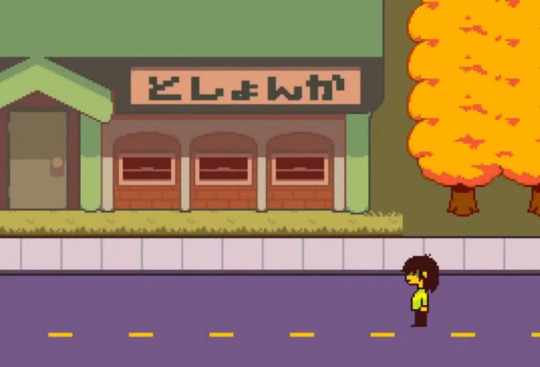
the AGREE2ALL puzzle was changed to say “YEEES20!!”. this can be read as “yes ni maru” (with the number 2 being read as “ni” in jp and “maru” being the word for a circle), meaning “yes to all” just like in english!

the “apple” keyboard puzzle still says “apple” though ralsei mentions that apple means “ringo” (the japanese word for apple) if you talk to him for a hint.
funnily enough, this joke was kept as is! (“kris, type as i say. f…” “…un!”)

the tasque’s battle lines in english are binary codes, with “me” being 0 and “ow” being 1. this is similar in jp. “nyan” is the equivalent of “meow” in that language, so “ny”=0 and “an”=1. cute!

the “bosom” joke is about the same, if anyone was curious
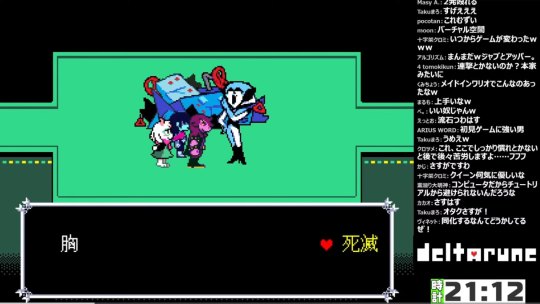


“breasts / annihilation”
“b…breast?”
“it means tity”
probably my favorite joke in the entire japanese version: in english, before the berdly fight on the roller coaster, he incorrectly refers to lightners as “Light Nerds” . in japanese this is changed to make him use ateji (a combination of kanji that doesn’t mean anything but sounds like an already existing word with their combined readings), calling the lightners 雷斗奈悪 (raitonaa, phonetically similar to the transliteration raitonā which the translation uses). it has the exact same effect (of berdly trying to sound smart but actually being very incorrect), but it’s localized in an outstanding way

“you are filled with the power of not knowing what sugarplums are” is changed to “you are filled with the power of not knowing what christmas pudding is”.

when berdly incorrectly calls susie “susan”, she says “who’s susan?” instead of “my name isn’t susan”. japanese people likely don’t know that “susie” is usually short for “susan”, so it makes sense for her to be even more confused in this version.

the spelling contest in berdly’s flashback is still an english spelling contest, with berdly specifying that it’s english.

instead of saying “susie… a real dragon blazers reference?!” when susie references dragon blazers 2, berdly says, “susie… you’re… a serious dragon blazers player…?!”
on that topic, dragon blazers is instead called dragon blader in japanese. was it called that the whole time? am i misremembering? i legitimately don’t know

the ice-e keysmash puzzle is changed so that you can type it out in japanese as すふぎおろてにぺけなも. it still does not mean anything.

right after susie referenced godzilla with the susiezilla line on the ferris wheel, she references ANOTHER tokusatsu. i think. here (while about to fall on ralsei) she says “ore, sanjou!!!!” (i arrive!), which is a famous catchphrase from kamen rider den-o. i’m like 85% sure it was an intentional reference. den-o is one of my favorite rider shows so this is amazing to me

and lastly. the name of minecrap is changed to マインクシャット (mainkushatto), which seems to be a play on some word plus “minecraft” like in english. i’m not sure what the wordplay is. i’ll get back to you on this
lore-y important stuff
about dess
in japanese, the december typing puzzle still spells out “december” in english.
noelle refers to dess as “onee-chan” (older sis)— it’s common for japanese people to refer to their older siblings like this, and it would be extremely weird if noelle called her “dess”. she could have called her “dess-neechan” or some variation of that, but i highly doubt that the name “dess” is being obscured, especially because “dess” transliterated would sound extremely close, if not alike to “desu” as well as the transliteration of “death”.
the knight
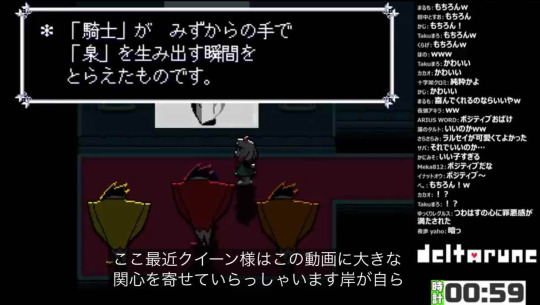
(i took the screenshot and forgot to turn auto captions off, sorry)
this line from a swatchling says something like “it captures the moment where the ‘knight’ creates a ‘fountain’ themself, with their own hands”, but the word for “themself” (みずから/mizukara) is written in hiragana, and “mizukara” could also technically be read as “from water”. was this a deliberate water-darkness parallel? i have no idea.
speaking of water!
the roaring knight is referred to as “咆哮の騎士” (houkou no kishi), the knight of the roaring. the word for the roaring itself, 咆哮, means roar or scream. which eliminates the alternate meaning of roaring (also being possibly defined as the sound of rushing water), but that probably doesn’t solidify “roaring” as solely meaning that. there are a lot of terms in undertale that had multiple meanings, but had to be changed to have only one in the japanese localization. “roaring” might be similar to those instances.
angel
spamton calls noelle an angel just like in english, referring to her as “angel-chan”. if there’s somehow anyone out there that didn’t think that line was important, i am here to prove you wrong!!!

more interesting:

this is the line where noelle says that if this was a dream, she would grow wings and fly away— but in this version, she says “big angel wings” specifically. very interesting!
the two (2) other notable changes in weird route
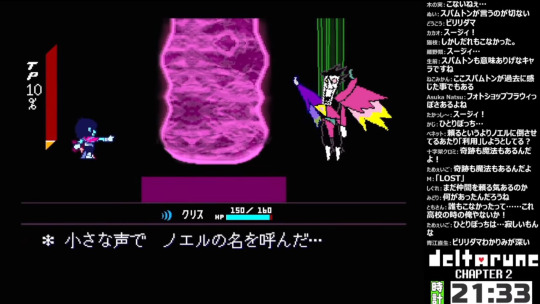
the infamous “you whispered noelle’s name…” line is slightly different. slightly.
the “kris called for help” lines still say that kris is the one doing it, but this one does not say the subject at all. this is normal for japanese, regardless, it’s still very interesting that it doesn’t say “you”. it is still differentiated from the “kris” lines, but not specifically referring to you (the player).
the other difference is so minor that i’m not even sure what it is or if it’s different from the english version.




translation
EVEN IF YOU [Shout] AT THE [Receiver]
YOUR [Voice] WILL EVENTUALLY WITHER
YOUR [Voice]
THEIR [Voice]
AND YOU WILL realize you’re alone.
i do not know who “THEY” is that spamton’s referring to. the term he uses is gender-neutral and singular. is he talking about the player? idfk probably not
miscellaneous spamton-related stuff
spamton’s speech patterns are entirely different in the japanese translation, but they get the same message across. they include:
switching between formal and informal language
using weird mixtures of hiragana, katakana, english letters and kanji
using katakana re (レ) instead of hiragana shi (し)
cutting off words
random spacing
and occasionally using “die” and “death” as homophones for “dai” and “desu”
it’s so wacky and unnerving and strange, i love it :D
other spamton lore bits:
mike’s name is the same (マイク maiku). i somehow forgot to translate the mike-related dialogue. i will get back to you all if there’s anything of note.

the word for “garbage noise” is 雑���, with about the same meaning. unsurprisingly, the same word (the exact same phrase, in fact) is used for both the addison’s line and the gaster phone call line.


the last thing (i think)
in the roaring cutscene, the japanese word for “chaos” is said (in the “all will be plunged into chaos” line), but then says the transliterated version of the word (カオス) in parentheses. tsuwahasu noted that it’s “keyword-like” in the playthrough i watched. is this important? i have no idea

i’m sure there are things that i missed here, so (again) if you want to know about something, don’t be afraid to ask!! the jp version of deltarune should be looked at a lot more—not just for the lesser-known lore tidbits, but also for the cool stuff that was changed to fit the language. it’s a really cool localization!
#deltarune#utdr#deltarune chapter 2#japanese#op#spamton#snowgrave#noelle holiday#kamen rider den-o#(<- i promise there’s a reason for tagging this)#translation
294 notes
·
View notes
Text
King pays tribute to ‘heroism and sacrifice’ to mark 80 years since Arnhem
Monarch’s words spoken by the Princess Royal to remember troops who fought in Operation Market Garden
21 September 2024 5:57pm

The Princess Royal is representing the King at the Arnhem anniversary events PA/Ben Birchall
The King has said the “heroism and sacrifice made by so many in the pursuit of peace” will never be forgotten as the 80th anniversary of a famous Second World War operation was commemorated.
The King’s words were spoken by the Princess Royal, representing the King at events this weekend marking the efforts of troops who in 1944 fought in Operation Market Garden, with the bold aim of ending the war that year.
The Princess, joined by her husband Vice Admiral Sir Tim Laurence, delivered her brother’s speech at a reception staged at the Airborne Museum Hartenstein in Oosterbeek, the Netherlands.
It is a former hotel that served as the headquarters of the British 1st Airborne Division during the Battle of Arnhem, part of the operation that aimed to push through the Netherlands and into Germany just a few months after the D-Day landings.

The Princess met Geoff Roberts, 99, believed to be the only British soldier to travel to Arnhem for the commemorations this year PA/Ben Birchall
The Princess said on behalf of the King: “Eighty years ago, on this very weekend, Operation Market Garden was under way in this region of the Netherlands.
“An ambitious joint airborne and ground forces operation designed to seize crucial bridges to enable the advance into Germany, its ultimate aim was to end the war within a matter of months.
“The friendships made during those difficult days of September 1944 between the Dutch and their liberators continued after the war.”
“I saw this for myself five years ago when, as Colonel in Chief of the Parachute Regiment, I attended the 75th anniversary commemorations.”
The Princess met Geoff Roberts, 99, believed to be the only British soldier to travel to Arnhem for the commemorations this year.
Mr Roberts flew by glider into Arnhem during Operation Market Garden but was captured as the Allies retreated after their efforts. Immortalised in the film A Bridge Too Far, the Allies were thwarted by strong resistance from Nazi troops, and he spent the rest of the war in a German prisoner of war camp.

The Princess Royal watches a fly-by at the Airborne Museum Hartenstein in Oosterbeek, Netherlands PA/Ben Birchall
The Princess continued the King’s speech, saying: “Tragically, despite the endless courage of all those who served in an operation whose renown echoes through the generations, the Netherlands had one more terrible winter to suffer before liberation finally arrived.
“Today, on this 80th anniversary, it is with a deep sense of gratitude and humility that we remember all those in the British, Allied and Commonwealth forces who served and died fighting for our freedom.
“Let us also remember those magnificently courageous members of the Dutch resistance and gallant civilians who endured so much during the Second World War.
“We will never forget the heroism and sacrifice made by so many in the pursuit of peace and liberation. My wife joins me in sending the warmest possible good wishes to all those taking part in this weekend of commemoration.”
On Sunday, the Princess, in her role as president of the Commonwealth War Graves Commission, will attend the annual service marking the operation’s 80th anniversary at Oosterbeek Airborne Cemetery.
She will join around a thousand guests and will read a lesson and lay a wreath at the foot of the Cross of Sacrifice.
Earlier, paratroopers from eight Nato member countries, including the UK, the USA, Portugal and Spain, parachuted from 12 aircraft into Ginkel Heath, a nature reserve near the Dutch town of Ede.
Some 700 paratroopers took part in the jump, including the Red Devils, the British Army’s freefall parachute display team, as part of the commemoration of the Battle of Arnhem.
Turned into defensive battle
Among those to parachute into the occupied Netherlands were 1,900 allied airborne soldiers from Britain’s 4th Parachute Brigade.
The plan involved seizing key bridges with a combination of airborne and land forces.
But the airborne forces’ landing zones were around nine miles from the bridge at Arnhem, losing them the element of surprise and giving the German troops time to build blockades.
While the operation succeeded in capturing the Dutch cities of Eindhoven and Nijmegen, it failed in its key objective: securing the bridge over the Rhine at Arnhem.
A defensive battle was fought, which saw nine days of prolonged street fighting, until the order to withdraw was given on Sept 25.
More than 8,000 British soldiers were killed, missing or captured in the offensive.
40 notes
·
View notes
Text

Trajectories for the Future
In "Dark tidings: Anarchist Politics in the Age of Collapse," Uri Gordon paints an ominous picture: "industrial civilization is coming down," so "anarchists and their allies are now required to project themselves into a future of growing instability and deterioration."[20] I am not so sure about the imminent downfall of industrial civilization or the collapse of capitalism, but I concur that we need to project ourselves into some image of the future in order to prepare for it.[21] A complication is that the future is partially decided by how we project ourselves into it and how we imagine it. There is not a predetermined future that we merely need to prepare for. It will be shaped by how we prepare for it and by what future we prepare for. To fixate ourselves on a particular vision of the future could affect us by constricting our capacities in the present to those actions that lead to that future, blinding us to other possibilities.
Gordon mentions some possible future scenarios, summed up as "grassroots communism, eco-authoritarianism, or civil war."[22] As the ecological crisis becomes more clear and people demand change, global capitalism might attempt to recuperate by making minor adjustments and putting on a "green face" without any changes in the system that is actually causing the crisis: capitalism itself. This can only buy time, and as the crisis intensifies capitalism will employ more authoritarian and repressive measures to stay in power. It can do this either in an authoritarian, neoliberal form, deploying superficial, liberal "progressive" rhetoric while preserving existing hierarchies; or it could instead turn to "eco-fascism," combining nationalist, racist and misogynist ideas of population control and "belonging" with the need to protect nature by totalitarian means. Both are tendencies that exist in the present.[23] In either case, it can only be a matter of buying time by managing the crisis until the inevitable collapse. In his piece Gordon suggests a number of praxises that are necessary in order to resist the authoritarian tendencies during this period of interregnum as well as to build alternative communities that prefigure a new way of life, independent of global capitalism.
Another, more recent, theory of possible futures is Geoff Mann and Joel Wainwright's (M&W) "Climate Leviathan."[24] They see four different trajectories: Either the capitalist order will continue under an increasingly authoritarian global sovereign - a planetary regulatory regime that decides who gets to pollute and at which cost ("Climate Leviathan") - or it will continue without such a sovereign as reactionary and nationalist movements refuse any serious collective efforts to mitigate climate change ("Climate Behemoth"). The global sovereign might also emerge as a non-capitalist world order: the state-socialist dream of a global centrally planned economy but with an emphasis on reducing carbon emissions ("Climate Mao"), and finally there is the more unknown path which involves a rejection and transcendence of both capitalism and political sovereignty ("Climate X").[25] Although climate denying "anti-globalist" right-wing movements have gained political power in several countries in recent years, the authors doubt this "Behemoth" will be long-lived: at some point the climate crisis will become so apparent it cannot be ignored.[26] They find the capitalist "Climate Leviathan" the most likely scenario as it can be built on global institutions and structures that already exist.[27] Climate X is less certain but is the only scenario the authors see as a viable strategy for the future.[28]
There are several overlaps between Gordon's and M&W's theories. Gordon's vision of eco-authoritarian capitalism is not that far from their Climate Leviathan: an attempt to manage the escalating crisis while preserving the existing structures of inequality. In his updated version, he admits that the prediction that capitalism would adapt by accommodating environmentalist and progressive concerns has not been realized. Instead capital has tended to "opt for full-blown reaction" expressed in climate denial and national chauvinism[29] - a trend that aligns with their vision of Climate Behemoth. The main point of convergence in the two theories is the hope for "Climate X" / "grassroots communism" - a movement of movements struggling for social justice, equality and self-management. My own theory is close to these. I also think we will see an increase in authoritarianism and inequality, but I posit that this is not really a change in the system but merely an intensification of the tendencies already contained within it. But the growing crises do give room for and force into existence other forces with the potential to create something new. I too, place my hope in "Climate X" - not as a utopian unknown but as concrete and existing praxises that can be expanded and amplified.
My aim here is thus not to critique the previous theories but to supplement them with empirical cases of what is already happening as the world responds to climate disaster - how the state and capital tries to consolidate the existing political structures on one side, and, on the other, how communities are responding by changing their social relations. Examining these cases from the present can give us a better idea of what to expect from the future and where to focus our struggles. I also add an element to "Climate X" that is under-emphasized in the aforementioned works, which focus primarily on protest and resistance to the dominating powers with the goal of preventing the destructive course.[30] Given the fact that climate disasters are already happening we also need to take into consideration how we are going to survive in the future. The politics of adaptation must be considered from the grassroots level.
#Climate Disruption#Political Stability#climate crisis#environmental justice#political philosophy#autonomous zones#autonomy#anarchism#revolution#ecology#climate change#resistance#community building#practical anarchy#practical anarchism#anarchist society#practical#daily posts#communism#anti capitalist#anti capitalism#late stage capitalism#organization#grassroots#grass roots#anarchists#libraries#leftism#social issues#economy
25 notes
·
View notes
Note
Hi! I've been reading through your character profiles recently (they're incredibly well done, and I love learning about less popular DC characters, so thank you for making them) and in one you said Hawkman mutilated his own godson, and now I'm overflowing with curiosity. Did he actually do that? Why? That sounds horrific.
It is SO BAD, friend!
So this happened during a 2004 JSA/Hawkman crossover called Black Reign in which Black Adam decides to liberate his home country of Kahndaq from a brutal dictator (and become, um, a benevolent dictator, but that's neither here nor there). To do so, he assembles the following squad:
Atom Smasher (Al Rothstein), who is there because he's frustrated that the JSA won't kill bad guys and also because he's hot for Black Adam
Brainwave (Hank King Jr.), who is there because he has a worm in his brain making him evil (yes really)
Alexander Montez, who is there because he's possessed by Eclipso
Nemesis, who is there because she's a random forgettable villain
And Northwind (Norda Cantrell), who is there because...
Well, we don't know! Norda, like Al and Hank, is a former member of Infinity, Inc. with a particularly goofy backstory: his father is Black human man and his mother is a bird lady who kind of looks like a sexy version of Woodstock from Peanuts. So Norda is a Black biracial man who is also part bird. He used to look like this:

He pretty much hadn't been seen for like a decade after Infinity, Inc. disbanded, but Black Reign reintroduces him like this:

Note his head and how much more animalistic it looks. Note the narrative box explaining that he can't speak anymore, because something something evolution.
Geoff Johns decided to take a Black character who had always been characterized as gentle, thoughtful, sensitive, and kind, and turn him into a savage, murderous animal, who is literally incapable of speech. He's the only character in this story given absolutely no motivation, because he cannot speak to express one. He's already been thoroughly dehumanized, and we haven't even gotten to the mutilation yet!
(It's also implied that Norda is the only one of Black Adam's squad, besides Adam, who knows that Hank has a worm in his brain that's controlling him/eating said brain, and just literally doesn't care. That's his friend! What the fuck!!)
Anyway, even though the people of Kahndaq welcome Black Adam as a liberator, the JSA decides to go into another sovereign nation and attack its new ruler with zero authorization from either the US or the UN, because obviously a Middle Eastern nation couldn't possibly have self-determination and a bunch of very very VERY old white American men know best. I'm not saying this is a simple political or ethical situation but I AM saying the story treats it like it is, and like the JSA completely and totally has the right to fart on over to another country and declare war. Probably worth pointing out that this was only three years after 9/11.
ANYWAY. Hawkman ends up fighting Norda, who is his godson, a fact which Hawkman reminds Norda of before doing this:

Jay is, correctly, horrified, and the following dialogue takes place:

It's okay! Sure, Carter ripped one of his godson's limbs out of its socket, but it'll probably grow back! Maybe!
It does in fact grow back, and it's worth acknowledging that Norda was totally ripping out random dudes' entrails at the beginning of this story so he's not exactly innocent here. But for me this particular moment has three key takeaways:
The obsession that comics in the post-9/11 era had with showing heroes doing ever more gruesomely violent, morally suspect things is just as exhausting now as it was back then, and ultimately contributes very little of substance to any conversations about heroism, justice, or the wars in the Middle East.
The treatment of Norda in this story is racist, full stop.
Norda has not appeared in any significant way in the 20 years since. He was never going to be a character with a major spotlight, but this sure didn't help.
14 notes
·
View notes
Note
as that anon message you got shows, the term "liberal" gets hurled around a lot as an insult on the left. what would you say are the necessary and sufficient conditions to be a liberal? i think having a straight answer for this would help remedy this sort of behavior
not sure what anon you're referring to. regrettably I don't think you're going to get people to stop using terms in loose or disagreeable ways no matter what, it just is the nature of political terminology (definitionally up for contestation) and language in general. part of the difficulty here is that the same term gets used to describe a political system, an ideology or hegemonic worldview, and a form of political identification
but as far as necessary/sufficient conditions go I like Charles Mills' formulation:
an axiology: committed to individual freedom to pursue the Good, governance by 'consent', the guarantee of specific political and economic rights (non-exhaustive list)
a social ontology: equal moral persons who are atomized or individualized and whose individuality, particularly their self-interested pursuit of their own Good, makes a functional society
a theory of history: endless progress, the accumulation of knowledge and the application of it to advancing human well-being (though this can be more or less Panglossian)
and would add a couple of my own:
a political methodology that gives priority to reform and positive law
an economic worldview that emphasizes the efficiency of money and markets and affirms private property as a central right (often *the* central right)
my own sort of working definition of liberalism writ large is that it's a kind of aristocratic legalism which has a key value of "security" (this is inspired by the work of Geoff Mann and Mark Neocleous), an investment in predictable, consistent outcomes that also expresses itself as a fundamental anxiety about the tenuousness of these institutions and of "civilization" as a whole (an interesting point of overlap between Keynes and Hayek). that's what I kind of see as the throughline between the combination of money, markets, law, and reform.
I would say that the elements listed above which automatically send up the yellow flag, for me, are the political methodology and the theory of history - either a sort of blinkered optimism/false realism about the ability to endlessly patch up our existing institutions or someone who has bought into a kind of linear historical narrative of constant improvement
even though I am not a market socialist and think that is probably excessively "liberal" for my own tastes, I think it is plausible to hold that position without being a liberal, if that makes any sense (it may not). inversely, the axiology of freedom, universalism, &c., often get cited as exclusive to liberalism, but I really don't think they are and remain unpersuaded by the various factions (commie, lib, postcolonialist, and so on) that have argued otherwise. not that I think ideas of freedom, equality, etc. are above conceptual critique per se, but I think I wouldn't assume somebody is a lib because they truck in that language.
64 notes
·
View notes
Note
I'm salty about The Ghost and Molly McGee's cancellation and how it's another example of networks and studios screwing over a show that didn't earn a profit despite doing next to nothing to help it earn a profit.
You got some fluffy headcanons about the show to help this poor salty soul.
Still mulling things over for post-series headcanons. I do have a few but I wanna wait till I have a good list and some designs before posting. I can give a few tho', 1 per major character.
Sharon worked through her grief of losing Scratch and created a series of wonderful art pieces which both hang in the Town Hall and in a museum in the capital.
Pete eventually manages to get a victory for Brighton over Perfektborg with an excellent redesign of the market district. While Perfektborg would win the next year, Pete was still hailed as a hero by the Brightonians.
Molly became Mayor of Brighton when she got old enough and felt she was ready to run, the previous Mayor Brunson even endorsed her run and she won easily. She has been enhappifying the town even more since for both the living and ghost citizens of Brighton
Daryl went legit...kinda. He still has some shady dealings but the other businesses he has are 100% legit (mostly thanks to Andrea's help and business know-how).
Libby became a popular author after with the encouragement of Molly, she sent in a manuscript and was published at 16. Since then she's been writing a bunch of stories of various genres (even outselling her father which brought her a bit of joy)
Andrea worked with Molly to rework her (Andrea's) life plan and it's been working great for her. The new "honest Andrea" image has been working well for her and has found it liberating not just for herself but against her family who has been trying anything to regain their empire, meanwhile Andrea has been happy separate from them
Ollie is a living therapist to the dead and has been helping ghosts with their unfinished business. While not his main job, it is the one he finds the most satisfying.
June continued her research on ghosts and now that actual ghosts are friends of her and family, she has direct test subjects. Her research was at first laughed at by "ghost experts" but after a few years of her advice was proven to work she got the respect that her parents never got.
Geoff & Jeff visited the McGees more often after Scratch left. While not the best at giving life advice, Geoff still tried to help Molly and co while growing up (Jeff, while supportive of his husband knows that he isn't the best with that stuff and would correct things)
46 notes
·
View notes
Text
No. 1 - G1, The Steading of the Hill Giant Chief (July 1978)
Author(s): Gary Gygax Artist(s): Erol Otus, Dave C. Sutherland III (cover), David A. Trampier Level range: Average of 9, preferably 5+ players Theme: Standard Swords and Sorcery Major re-releases: G1-3 Against the Giants, GDQ1-7 Queen of the Spiders, Against the Giants: The Liberation of Geoff, Dungeon #197, Tales from the Yawning Portal
I'm not sure if G1-G3 are the most remastered adventures of all time, but it's gotta be competitive. I think Tomb of Horrors might have it beat, but I haven't counted. The 4e conversion [the Dungeon #197 one] is really weird in particular because…4e feels like the edition least interested in the legacy of DND? It was boldly doing its own thing. A good quality, actually.
Anyway, it's time to slag off* on a beloved adventure. Note, I am using the earliest copy of G1 I can find, which is from waaaay later when D3 was complete. I apologize.
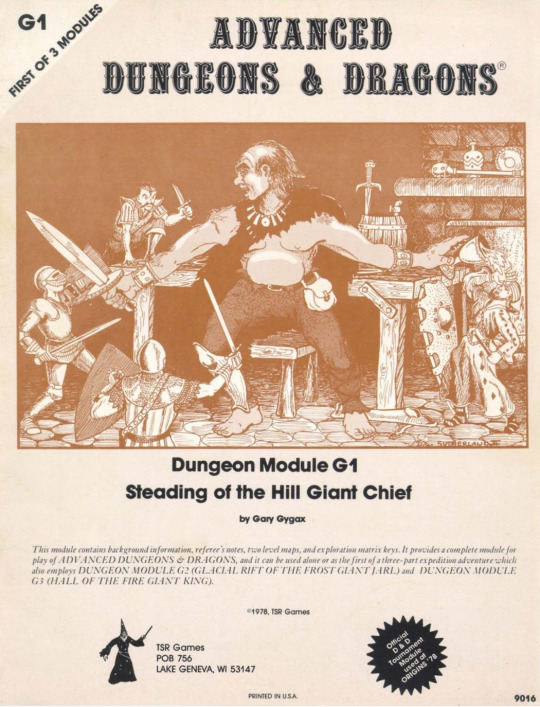
*And by slag off, I mean "be critical of at all". In practice, this module is actually showing some unusual acumen compared to its contemporaries.
EDIT: I forgot to mention a rather important thing when this was made live -- note the title there! We are officially in ADND land now, so put away your little brown booklets and switch over to the fuck-off awesome player's handbook with the iconic Moloch statue!
Somehow I had gotten my whole life at this point never really…understanding what this structure was supposed to look like? It looks like this.

I honestly think exterior shots of dungeons are critically underrated. Handouts are amazing and being able to flash the back cover art to safely show the party "like this" is actually great, I deeply wish that….any? of the previous modules had done that? I think the only one that did was Tsojconth. Weirdly, the interior drawing is very subtly different. Look at how the logs face:

Not a huge deal but, a kind of weird inconsistency that top one looks like a stockade and the bottom one looks like a log cabin. Side note, we know that the long dimension of this is using 210 feet tall logs, which is to say, the size of an average redwood. These are some big fuck-off trees -- which could be a very interesting detail about the local area.
Now the setup is pretty simple. You were hired to go beat up the giants because they've been raiding the local humans, figure out why they're raiding, and comeback posthaste. The locals have kitted you out with horses, guides, maps, et c -- but no compensation, they have simply omitted a finder's fee (cheap bastards). Also, if you fail, they'll execute you. With friends like these, who needs Giants?
Gary starts with some mild railroading (you accepted the job already, you are already kitted out, you already walked to a nearby cave, you waited til dusk to approach, you notice two guards are missing, and the cave is guaranteed to be moderately hidden. Sure, whatever, I'm going to ignore that if I run this tho. Gary notifies us of a few critical details:
Don't run this stock, that's immoral
Any surviving giants will flee to G2 if they have the opportunity (which, kind of inherently punishes clever play that avoids combat?)
There is a 2% chance per round that the wooden structure will be lit on fire due to chronic rain (why is this a dice roll??)
If you will permit me a tangent, player arson is truly the bane of interesting scenarios everywhere. Whenever a player wonders, "why are all the GM's dungeons underground or in stonework buildings?", it's because doing anything else invites arson as the default and best answer to all problems. Magic items are fireproof and most metal items will not get hot enough to be destroyed, so very often the best solution is to burn the place to the ground and loot it the next day. So, yeah. No wood buildings. Gary's fix is to have all the giants flee into the basement, then waste a week of the PC's time for daring to use arson. Kind of sucks!
Tangent complete.
Here's some random interesting bits:
Gary explicitly states that you can pass yourself off as hill giant kids, which is extremely funny. Minus the implicit child murder.
Naturally there are giant moms doing giant housemaid shit in several rooms. Presumably they have giant curlers too.
The secret door is, literally just a doorway covered by a pelt. I have to hand it to them, that'd trip up most players in 2024 AND make them feel stupid for not figuring it out!
The big reveal that Eclavdra the Drow is secretly behind it all is so lightly teased that it feels downright tasteful.
A giant that uses a ballista as a crossbow (based) and spears for arrows (also based) -- between the prevalence of lightning spears and greatarrows, one starts to think of a certain famous video game. Genuinely I think it'd be a fun exercise one day, for someone who is more knowledgeable than me about Japanese fantasy roleplaying culture, to talk about how anglophone fantasy works made their way into Japan and were interpreted.
One of the cloud giants has hidden a sentient giant slaying sword that speaks all the giant languages, it feels like there's a hell of a story going on there that is only alluded to!

To my knowledge, this is the first official depiction of an orc in DND? Which implies that Gary is team pig-orcs, which is cool. Frankly, I love porcine orcs, or even better just pigfolk in general, they're great.
I think it is actually a rather bold early stance for Gary to hold that, even here in 1978, Chaotic aligned creatures are not automatically friends. Granted, that's how it is in Elric, so it's not THAT bold, but clearly everyone else missed the memo. The orcs are willing to side with you at least in the short-run, and in our previous modules it was very rare to have groups of chaotic-aligned creatures fighting one another. It was always just personal beefs. In fact, the overall theme of G1 so far is that despite the boxy-ass dungeon design, there's already a command of naturalism that even modern dungeons really struggle with. Factionalism truly is the gift that keeps on giving for the GM!
So the big reveal internally to G1 (just think of that -- a reveal internally to G1, and externally to the GDQ supermodule -- we're already getting pacing!) is that the orc slaves have rebelled. And -- hey -- good for them. There's also a kind of…built-in companion refill system going on here? So in oldish DND the way it works is, the expectation is the party is not just 5 guys with swords. You've got companions to help fight, and you've got hirelings to do other stuff (test suspected traps, if you're evil). And you can only hire so many of these guys from town, but attrition is going to happen. So the modules simply provides, automatic replacements should you negotiate worth a quarter of a shit. A dwarf slave here, an orc slave there. Maybe a giant dissenter if you're really clever. One of the potential "rewards" you can get is more dudes to throw at problems.
More interesting bits
There is, what I can only really call an abortive idea going on here where there's a scary temple in the basement? But no one worships there and no information is provided. It is merely a fucked up altar. I think I vaguely recall that it's retconned Tharizdun in one of the remakes? They always retcon things to be Tharizdun. Busy man, Tharzy.

Gary, Gary no. Stop it. Stop this 78 guys bullshit. I thought we had established that giant rooms of giant clumps of guys was bad. I know you have terminal Napoleonics brain but stop.

Wait, Steading is a noun? I always thought it was a verb. Yknow, like "Steading those hill giants", taking 'em down a notch. Apparently, a Steading is a small farm -- same etymology as Homestead. I guess mark that as our first Gygaxism?
Our second Gygaxism is gill, which is "a quarter pint of an alcoholic drink", which is to say a few mouthfuls

Always end your adventures with weird, ominous non-diegetic text. On the flip-side, absolutely do not do what the adventure does, and end on a teleporter that takes you to the next dungeon. That is the worst option.
Anyway, that's the whole Hill Giant situation. Honestly, it's better than I remembered, but in proud module tradition up to this point it gets weirdly filler-y in the basement. There's just something about basements that makes dungeon designers stop giving a shit, I swear. I do need to give the man his due, even though he was a shitass person: Gygax wrote an 11 page module that is of noticeably higher killer-to-filler ratio than any of his contemporaries. G1 is better than any of its predecessors, pound for pound. It is way, way shorter which is I suppose a plus to me and a minus to others, but -- there is a clear internal logic to this place that is tragically missing from (say) The Dwarven Glory. And that internal logic is the beginning of good adventure design. Anyway, we have two fun tidbits to discuss before we end for the day.
First up, we have an of-the-time account of events in Dragon #19! It turns out that in Origins '78 they played G1-G3's prototype. The account is of the winners (mostly West Virginians, a few Michiganders), who used their magic extremely liberally to hide what they were doing as well as to scout. They did opt to light the place on fire, good for them! If you want to check this out, it's on page 3. I will mention G2 and G3 here as relevant later.
Second up, there's a weird interquel hiding in Dungeon #198! Hanging out as an informal G1.5 is "The Warrens of the Stone Giant Thane!" I will not review it in full because my understanding of 4e is, basically just skimming the PHB and reading the DMG, but essentially the Stone Giants are hypothetically aloof and not particularly loyal to their Fire Giant superiors, but someone gave them The Rock That Makes You Crazy and so now they are. Smash the rock!

Man, map design in the 4e era was so fucking bad. It looks fine, but like, this is four circles. And downstairs is, of course, cave as far as the eye can see. Aren't stone giants supposed to be skilled carvers? Anyway, If you feel like G2 would be too big of a jump mechanically compared to G1, this exists. I'm sure you could use it if you liked, and certainly there is a Genre of Grognard who would be kinda tickled at the thought of finding "lost content" for el classico GDQ.
Next week, we cover G2, which was also in July. So was G3! They're triplets!
18 notes
·
View notes
Text

Against the Giants: The Liberation of Geoff Cover Art by Gerald Brom
130 notes
·
View notes
Text
By: Julian Adorney, Mark Johnson and Geoff Laughton
Published: Jun 29, 2024
American communities have been systematically hollowed out over the past 50 years. In Bowling Alone, Harvard political scientist Robert Putnam makes an exhaustively-researched case that confirms what most people who lived through this period already know: community life is on the decline. For most of the first two centuries of American history, people were enmeshed in a dense web of civic associations. We bowled together, attended church, participated in Rotary Club meetings, and volunteered for local political groups together. We played bridge with our neighbors and gathered for regular book clubs.
This vibrant communal engagement fostered a deep-seated trust among neighbors. In 1964, a remarkable 77 percent of Americans agreed with the statement, “most people can be trusted.” But starting in the 1970s, the fabric of American society began to unravel. The strong community bonds that once unified us began to fray, one by one; and our social capital (Putnam’s term for the “connections among individuals—social networks and the norms of reciprocity and trustworthiness that arise from them”) has decreased dramatically.
For instance, Putnam notes that while the total number of national nonprofit associations more than doubled from 1968 to 1997, the average membership per association plummeted—from roughly 10,000 in 1962 to around 1,000 in 1988. This translates to an almost 80 percent decrease in the number of Americans involved with national nonprofits over three decades. Additionally, Putnam cites time diaries showing that in 1965, Americans spent an average of 3.7 hours per month in non-religious organizational activities, such as Key clubs, Rotary clubs, bowling leagues, and others. By 1995, that number had fallen to 2.3 hours per month.
It’s not just organizational ties that are being frayed; we’re spending less time with friends too. As Putnam notes, “In the mid-to late 1970s, according to the DDB Needham Life Style archive, the average American entertained friends at home about fourteen to fifteen times a year. By the late 1990s that figure had fallen to eight times per year, a decline of 45 percent in barely two decades.”
Since the publication of Bowling Alone in 2000, the societal disengagement Putnam described has gotten worse. The rise of social media and streaming services like Netflix are keeping us increasingly alone in our rooms, plugged in but disengaged from meaningful interaction with our fellow humans. A 2018 Adobe report focusing on the United Kingdom found that Millennials spend an average of 8.5 hours per day engaging with online content. For Generation Z, that number rises to an astounding 10.6 hours per day. When you account for hours spent sleeping, there is little time left for young people to engage in face-to-face community activities. Indeed, data show that they’re not engaging. In his book The Anxious Generation, social psychologist Jonathan Haidt notes that the percentage of middle- and high-school students who report meeting up with friends “almost every day” outside of school has fallen dramatically since the 1990s—a trend exacerbated by a global pandemic that confined everyone to their homes for two years.

[ Source: https://www.anxiousgeneration.com/research/notes-and-figures ]
What does the decline of community life since the 1970s have to do with rising illiberalism? As social animals, our sense of connection greatly influences our happiness. A study published in The Journal of Socio-Economics highlights just how essential community is for our well-being. This study surveyed 10,000 adults in England, examining the factors that make them happy or unhappy. Surprisingly, money didn’t seem to matter much. According to the authors, “Income only plays a small part in influencing our well-being.” Instead, a sense of community was paramount to participants’ happiness. In particular, having a single close friend was deemed as valuable as an additional $150,000 in yearly income.
In 2021, nearly half of Americans (49 percent) reported having three or fewer close friends, a significant drop from 27 percent in 1990. Maybe that’s why so many Americans are unhappy these days. According to Gallup’s 2024 World Happiness Report, America ranks 23rd in global happiness. An MSNBC report also notes that “Self-reported happiness in the U.S. has been on the decline for the past two decades.” Furthermore, 32.3 percent of American adults—and a stunning 49.9 percent of young people aged 18-24—suffer from anxiety or depression.
Could this widespread dissatisfaction with modern life be causing a shift away from liberalism? Data suggests it might be. A study published in the prestigious Proceedings of the National Academy of Sciences titled “The rise and fall of rationality in language,” systematically analyzes the relative frequencies of emotional and rational words in massive databases of written language, from Google Books and the New York Times, from 1850 to 2019. Emotional words such as “angry,” “unexpected,” “embarrassed,” and “tortured” are contrasted with rational words like “indicate,” “area,” “program,” and “determine.” The study found that from 1850 to the 1980s, the relative proportion of emotional words consistently decreased, while rational words increased. However, starting in the 1980s, a reversal occurred; our discourse became more emotional and less rational. By 2019, the use of rationality-related words had declined to levels not seen in over a century.
What does this decline in rationality signify? The authors suggest that it might reflect a growing “disillusion with ‘the system.’” As they note, “rationality…helped build and defend the system” in which we all live. Thus, a move away from rationality might reflect our collective anger at the liberal social order that we think is making us lonely and disconnected.
The connection between social isolation and political illiberalism isn’t new; it has been well-established by social psychologists. As Haidt writes in The Righteous Mind, social connectedness serves as a bulwark against totalitarianism.
If people can’t satisfy their need for deep connection in other ways, they’ll be more receptive to a smooth-talking leader who urges them to renounce their lives of “selfish momentary pleasure” and follow him onward to “that purely spiritual existence” in which their value as human beings consists.
In contrast, “a nation that is full of hives [Haidt’s term for civic associations] is a nation of happy and satisfied people. It’s not a very promising target for takeover by a demagogue offering people meaning in exchange for their souls.”
Putnam argues that social isolation may fuel political extremism for a different but related reason: it puts us into echo chambers, which moves us politically towards the fringe.
When people lack connections to others, they are unable to test the veracity of their own views, whether in the give-and-take of casual conversation or in more formal deliberation. Without such an opportunity, people are more likely to be swayed by their worst impulses. It is no coincidence that random acts of violence, such as the 1999 spate of schoolyard shootings, tend to be committed by people identified, after the fact, as “loners.”
In other words, when we feel lonely, adrift, and unhappy, we may be more susceptible to the appeals of extremists on both the left and the right who promise community and utopia contingent on our willingness to overturn the existing social order.
So, if a decline in community life is fueling a demand for illiberalism, what can we do about it?
First, we can robustly and emphatically defend liberalism. We can clarify to people that their social malaise is a product of many factors unrelated to liberalism, and that abandoning a liberal social order is unlikely to alleviate it. We can peel back the curtain and reveal the realities of societies that have moved away from political, economic, and epistemic liberalism, demonstrating how these changes often worsen people’s lives. This is essential work, and we are indebted to the many great organizations and websites (including Reality’s Last Stand and New Discourses) that have been doing it.
But even as we articulate the benefits of liberalism, there is another approach we can simultaneously pursue: rebuilding the American community.
Putnam’s analysis is bleak, but he shares an essential silver lining: we have been here before. At the end of the 19th century, Americans faced many similar issues. Rapid industrialization had ushered in unprecedented material prosperity, but small towns and rural villages were being gutted. Increasingly, people found themselves lonely, adrift, and disengaged—but they recognized the problem and went to work. They founded churches, schools, clubs, and political organizations, sparking a social renaissance. Here’s how Putnam describes the “massive new structure of civic associations” that emerged as a result:
In the last decades of the nineteenth century Americans created and joined an unprecedented number of voluntary associations. Beginning in the 1870s and extending into the 1910s, new types of association multiplied, chapters of preexisting associations proliferated, and associations increasingly federated into state and national organizations. In Peoria and St. Louis, Boston and Boise and Bath and Bowling Green, Americans organized clubs and churches and lodges and veterans groups. Everywhere, from the great entrepôt metropolises to small towns in the heartland, the number of voluntary associations grew even faster than the rapidly growing population.
This civic renewal helped to knit the country back together. It rebuilt a new wave of civic associations to replace the ones that had been frayed or bulldozed by rising industrialization.
So, what if we did the same? What if our commitment to defending liberalism inspired us to look out and up, rather than merely down and in? What if we joined—or founded—PTAs, local churches, Rotary Clubs, and sporting leagues? What if we invited others in our community and networks to join with us, especially those who seem lonely and disaffected?
By fostering a civic renaissance, we could not only become happier and more connected; we could also address the root cause of illiberalism at its source.
-
About the Authors
Julian Adorney is a columnist at Reality's Last Stand and the founder of Heal the West, a substack movement dedicated to preserving liberalism. He’s also a writer for the Foundation Against Intolerance and Racism (FAIR). Find him on X: @Julian_Liberty.
Mark Johnson is a trusted advisor and executive coach at Pioneering Leadership and a facilitator and spiritual men's coach at The Undaunted Man. He has over 25 years of experience optimizing people and companies—he writes at The Undaunted Man’s Substack and Universal Principles.
Geoff is a Relationship Architect/Coach, multiple-International Best-Selling Author, Speaker, and Workshop Leader. He has spent the last twenty-six years coaching people world-wide, with a particular passion for supporting those in relationship, and helping men from all walks of life step up to their true potential. Along with Mark, he is a co-founder of The Undaunted Man.
==
Not churches, but okay.
#Julian Adorney#Mark Johnson#Geoff Laughton#liberalism#isolation#illiberalism#community#psychology#human psychology#disconnected#liberal ethics#liberal values#unhappiness#depression#anxiety#mental illness#mental health#mental health issues#religion is a mental illness
5 notes
·
View notes
Text
by Geoff Chang and Jordan Crane
In early 1887, C. H. Spurgeon published a paper in The Sword and the Trowel that, unbeknownst to him, would kindle a flame in the Baptist Union. This flame grew into the fiery debate, known as the Downgrade Controversy, that engulfed Baptists for the coming years. The altercation sent Spurgeon and the Baptist Union careening towards a dramatic outcome: separation. Spurgeon refused to continue to exist in association with ministers and churches that had left biblical truth for the “New Theology” of theological liberalism.
In response to these charges, the leaders of the Baptist Union insisted that Spurgeon should produce evidence of this theological drift by naming names. Who were these unorthodox ministers with whom Spurgeon refused to associate? Until he produced evidence of his claims, the Union refused to acknowledge his claims that theological liberalism had begun to infect the Baptists. All this put Spurgeon in a…
3 notes
·
View notes
Text
Nikki Haley suspended her campaign for the GOP presidential nomination months ago and has not campaigned since. But she still got 21.7% of the vote in Tuesday's Republican primary in deep red Indiana. She passed the 30% mark in four Hoosier counties including Marion where Indianapolis is located.

If a fifth of Republicans go out of their way to vote for a non-candidate this late in the race to show their objection to Trump, it doesn't bode well for The Donald in November.
While Indiana should still be considered solid for Trump, the continuing significant showing for Haley could mean trouble for him in toss-up states like Georgia and Pennsylvania.
Former President Donald Trump faced warning signs in the Indiana GOP primary as former Republican rival Nikki Haley received more than 20 percent of the vote despite dropping out of the White House race two months ago. [ ... ] Haley also received more than 26 percent and 18 percent of the GOP primary vote in the key swing states of Michigan and Arizona respectively, amounting to hundreds of thousands of votes. Several polls have indicated that many Haley supporters will not go on to vote for Trump in the 2024 election.
Trump has a problem even if 75% of those Haley voters in GOP primaries decide to hold their noses and vote for Trump in November.
Trump's appointment of anti-abortion fanatics to the US Supreme Court who then overturned Roe v. Wade does not sit well with some pro-choice Republicans.
And those Trump comments about being a "dictator on day one" and "retribution" should horrify anybody concerned about the rule of law.
A Republican former lieutenant governor of toss-up Georgia announced that he's voting for Joe Biden in November.
Former Georgia Republican Lt. Gov. Geoff Duncan says he is voting for Biden in November
Mr. Duncan understands that the only way to defeat wannabe dictator Trump is to vote for Biden. Casting a blank ballot, writing in somebody, or voting for an impotent third party will do nothing to protect democracy in 2024. That goes for liberals as well as conservatives.
#donald trump#indiana primary#indiana#republicans#nikki haley#never trumpers#dictator on day one#abortion#geoff duncan#georgia#election 2024#vote blue no matter who
9 notes
·
View notes
Text
'All of Us Strangers may have missed out on awards earlier in the year (no Bafta wins, no Oscar nominations) but it has won the prize that matters: the Guardian’s best film of 2024. It is the second time that director Andrew Haigh has received this accolade – 45 Years, his searing study of a marriage plunged into crisis, was the Guardian’s choice as best film for 2015.
On the face of it, the two films are sharply contrasting expressions of Haigh’s craft. 45 Years is resolutely realist in its portrait of a retired couple living in Norfolk, investing its middle-class milieu with an understated arthouse aesthetic. All of Us Strangers, meanwhile, returns to the gay themes that marked Haigh’s breakthrough Weekend, but in a shift from his past work operates in an unstable, dreamlike atmosphere that ultimately calls into question whether anything we are watching is supposed to be real.
But the two films share a powerful theme in common: the past’s hold over the present and the unnerving realisation that while we can never revisit our past, it has ways of finding us, sometimes shocking us into a new sense of ourselves.
Working in both cases from source material by other writers, Haigh alights on two brilliant conceits to explore this idea in each film.
In 45 Years, adapted from a short story by David Constantine, Geoff (Tom Courtenay) learns that the body of his old girlfriend Katya has been found more than 50 years after she fell into a crevasse in the Alps. This discovery disinters memories and passions that have lain deep inside Geoff, while his wife, Kate (Charlotte Rampling), scrambles to prevent the disintegration of a long and apparently happy marriage.
We never find out if Geoff makes the journey to see Katya, and we never see the body – but it looms large in our minds. As in Greek tragedy, the horrors of death are kept off stage, all the more to set our thoughts racing. In its ice-preserved youthfulness, Katya’s imagined body somehow rebukes the old age into which Geoff and Kate have sunk.
Kate is twice confronted with the image of the young Katya: in a photograph Geoff shows her (there is a resemblance between the two women) and then, in an unforgettable, Hitchcockian scene, through the primitive magic of a slideshow, which reveals Katya was pregnant.
Haigh finds an equally unsettling way to dramatise the collision between the past and the present in All of Us Strangers (which was inspired by a novel by Japanese author Taichi Yamada). Adam (Andrew Scott) has a series of encounters with his parents (Claire Foy and Jamie Bell) as they were when he last knew them, before they died in a car crash when he was 11. They have not aged in appearance and behave as if it is still 1987, yet recognise that Adam has got older – perhaps a little older than they are. They are unchanged artefacts from the past, just like Katya in 45 Years, unattached to the present and yet acting upon it.
Readings of All of Us Strangers vary, but it seems that these eerie meetings in Adam’s old childhood home may be visions from his subconscious as he wrestles with the devastating effects of losing his parents so young – as well, perhaps, as scenes from the script we see him starting. Haigh presents us with two intriguing thought experiments: what if you could meet people from your past and have the conversations you were never able to have? And what if you could talk to your parents now as they were when they were bringing you up, meeting as equals? These scenes are so carefully scripted and impeccably acted that what is inherently unreal feels intensely authentic.
In both films, the intrusion of ghosts from the past is highly disruptive. Kate and Geoff go through with their 45th wedding anniversary party, but we are left wondering if their marriage can survive. For Kate, the revelations about Katya have cast her life with Geoff into a disturbing new light, as if it were all built on a false premise. Kate seems to intuit that Geoff loved Katya more than her, and that this old relationship has shaped their marriage without her being aware of it.
Meanwhile, Adam’s meetings with his parents seem to have been part of a reckoning with long suppressed trauma on multiple fronts. In parallel with his home visits, he has embarked on a doomed relationship with Harry (Paul Mescal), which we come to interpret as another fantasy in which he plays out his apparently unfulfilled desire for a loving relationship with another man.
Both films threaten to bear out Oscar Wilde’s line that “one’s real life is so often the life that one does not lead”. Adam’s story is suffused with the sadness of bereavement and lost opportunities, but it could be regarded as more optimistic than Kate and Geoff’s in 45 Years. Adam seems to have undergone a kind of cathartic process, and – assuming he is still alive at the end of the film (as Scott says he is) – he has found, in the world he has conjured up in his mind, a potential path to happiness in the future. Kate and Geoff have much less time ahead of them to find an authentic way to live, whether together or – as seems more likely – apart.
But whatever future awaits his characters, Haigh seems to be reminding us that the past will always cast its shadow over us, whoever we are. You don’t have to have lost your parents in a car crash to mourn the passing of your childhood world; you don’t have to be haunted by a decades-old tragedy to be troubled by the way your life has turned out. Haigh’s innovative exploration of our vexed relationship with the past gives both these remarkable films their deep melancholy power.'
#All of Us Strangers#45 Years#Film of the Year#Andrew Haigh#Tom Courtenay#Andrew Scott#Paul Mescal#Charlotte Rampling#David Constantine#Taichi Yamada#Claire Foy#Jamie Bell#Oscar Wilde#Oscars#BAFTA
2 notes
·
View notes
Text
If, as Negri says, “the necessity of Keynesian ideology” arises in a “tension born of desperation,” it is not provoked by communism but by the onset of bellum omnium contra omnes that looms on the Keynesian horizon.31 This is the tension that motivates Keynes’s most famous contribution, The General Theory. That work, and virtually all those concepts and policies we call Keynesian, are essentially moments in a political economy of anxiety and hope—efforts to subdue the sources of social disorder and animate the untapped social and economic wealth immanent to what Keynes called “modern communities.” … Far more than the renewed interest in Keynesian economics, or Keynes the economist or statesman, it is the precariousness of “civilization” that makes the question of Keynesianism urgent. We are witness to the desperate refusal to abandon the belief that a non-revolutionary bliss is out there to be realized, that “something will turn up.” This anxious hope and trepidation are not confined to elites, governors, or the ruling class, and they exceed the realm of liberal politics. They are, rather, widespread across otherwise quite rigid lines of difference—millions of us have become, as Keynes was once described, “Geiger counters of future headlines.”33 ...
This cul-de-sac is precisely where Keynesian reason leads us. Many of those political features that make Keynesianism make sense to “progressives” are significant obstacles to a vital, mass-based progressive or Left movement—that is at least part of Keynesianism’s raison d’être. I am of course far from the first to point this out; some variation on it is a “radical” axiom. The problem that is almost never mentioned, however, is that recognizing Keynesianism’s limits, or even excoriating it for its “reformist” or “collaborationist” bases (as some “radicals” are often wont to do), does not thereby cut the ties that bind the Left to Keynesianism. Keynesianism is not something that the Left in the liberal capitalist North can just disavow at will. It has always been a crucial element of that social formation, and there is no politics that can escape its time. Keynesianism has been at the core of both liberalism and the critique of liberalism for more than two hundred years.36 It is, unintentionally but inescapably, no small part of what “progressive” or “Left” has come to mean, however much some might wish it were otherwise.
- Geoff Mann, In the Long Run We Are All Dead, 2017
#there's so much good i cut out of this excerpt too#the core of it is very depressing: it's a diagnosis of a liberal psychology with no solution. but the way it's presented is very gentle
2 notes
·
View notes